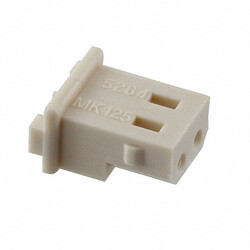“Polarity” is one of those terms that gets thrown around quite a bit in electronics, and which can have multiple meanings. We frequently receive questions about polarity for products that one would not normally consider ‘polarized’. As one example, we’ll take the Molex Mini-SPOX series connector 0050375023 housing, which we’ve received polarity questions about recently. Does this device have a polarity, and how can you tell?
“Polarity”, in this case, can have one of two meanings. The more commonly understood one, and the one that frequently prompts “polarized?” questions, is electrical polarity i.e. a “plus” side and a “minus” side to the product. Per our existing post on polarity, passive connectors such as this Mini-SPOX device are not electrically polarized. Without any energized components to power or internal circuitry to energize, the device fundamentally cannot be polarized in this way. This is a very common misunderstanding concerning electronics, as many people unfamiliar with the industry presume that ALL components must be polarized and have a ‘plus’ and a ‘minus’, or a ‘Pin 1’ that indicates the same information.
For connectors specifically, the term “polarity” can also mean physical polarity, i.e. features of the housing that ensure it can only connect to its designated mating product in a single way. This Mini-SPOX product is physically polarized in this way, as are most connectors. This type of polarization is more commonly referred to as “keying”, with physically polarized connectors usually called keyed connectors. When mating to this connector’s designated mates, this device’s polarization is visually verifiable and intuitive.
Attempting to mate this device to something other than one of its designated, designed-for mates is generally an exercise in futility - modern connectors are usually carefully designed to avoid exactly this sort of wrongful intermating as a way of reducing human error in equipment assembly. Usually this happens when someone is attempting to jimmyjohn a cable-to-board connector pairing like this Mini-SPOX set into a cable-to-cable connection, such as inserting an extension cable or trying to adapt equipment to an unintended purpose. If your situation requires you to do this, it’s generally best to replace the connector pairing entirely rather than trying to force an existing keyed connector such as 0050375023 to mate to something it’s not designed to mate to.

